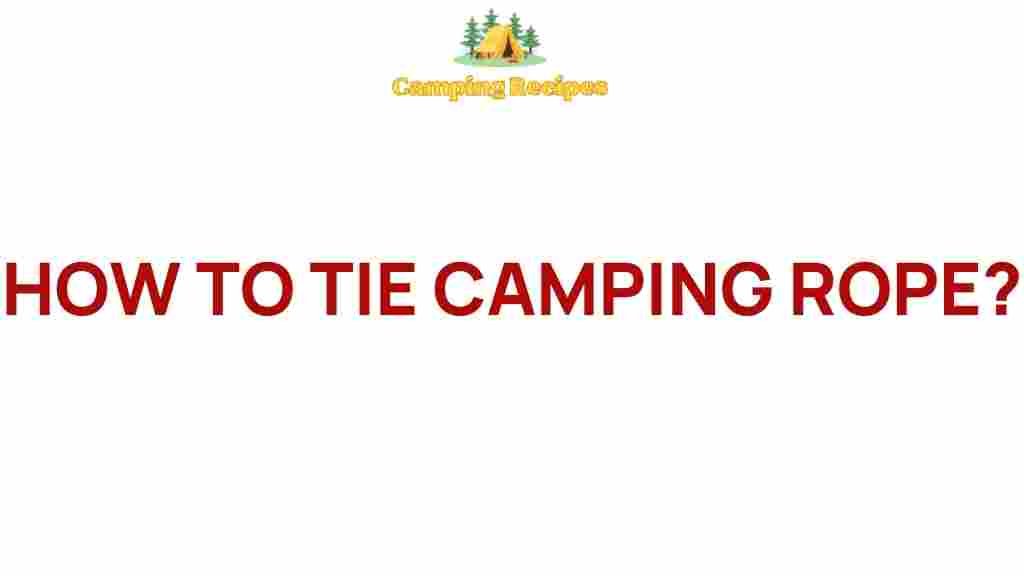Mastering Camping Rope: Essential Knots Every Adventurer Should Know
When it comes to outdoor adventures, mastering the art of using camping rope is a crucial skill that every adventurer should possess. Whether you are hiking, camping, or engaging in any outdoor activity, knowing how to tie various knots can significantly enhance your experience and ensure your safety. In this article, we will explore essential knots that every adventurer should know, along with practical tips and techniques for using camping rope.
The Importance of Knots in Outdoor Skills
Knots are not just for sailors or climbers; they play a vital role in a wide range of outdoor skills. Here are some key reasons why understanding knots is essential for any outdoor enthusiast:
- Safety: Properly tied knots can prevent accidents and ensure that your gear remains secure.
- Versatility: Different knots serve various purposes, from securing tents to creating shelters.
- Efficiency: Knowing how to tie knots quickly can save time during setup and takedown.
- Survival: In emergency situations, the ability to tie knots can be crucial for securing gear or creating makeshift solutions.
Essential Camping Rope Knots
Below are some of the essential knots that every adventurer should master. Each knot serves a different purpose, and understanding when to use them is key to effective rope tying.
1. Square Knot
The square knot is one of the most commonly used knots in camping and outdoor activities. It is perfect for tying two ropes together and is often used for securing bundles.
How to Tie a Square Knot:
- Take two rope ends, one in each hand.
- Cross the right end over the left.
- Wrap the right end under the left and pull tight.
- Now, cross the left end over the right.
- Wrap the left end under the right and pull tight again.
Tip: Make sure the knot is flat; if it’s twisted, it can slip.
2. Bowline Knot
The bowline knot creates a fixed loop at the end of a rope, making it ideal for rescue situations or securing items without slipping.
How to Tie a Bowline Knot:
- Make a small loop in the rope, leaving a long end.
- Pass the long end through the loop from underneath.
- Wrap the long end around the standing part of the rope.
- Bring the long end back down through the loop.
- Pull both ends to tighten.
3. Clove Hitch
The clove hitch is an excellent knot for securing a rope to a post or tree. It’s easy to tie and untie, making it perfect for quick setups.
How to Tie a Clove Hitch:
- Wrap the rope around the object once.
- Cross the working end over the standing part.
- Wrap the rope around the object again, this time going in the opposite direction.
- Tuck the working end under the last wrap and pull tight.
4. Taut-Line Hitch
The taut-line hitch is adjustable, making it perfect for securing tent lines or tarps. This knot allows you to easily adjust the tension as needed.
How to Tie a Taut-Line Hitch:
- Wrap the rope around the anchor point.
- Make a loop with the working end, placing it over the standing part.
- Wrap the working end around the standing part twice.
- Pass the working end back through the loop.
- Pull to tighten, and adjust the loop as needed.
5. Figure Eight Knot
The figure eight knot is essential for climbing and rappelling. It creates a secure loop and is easy to inspect.
How to Tie a Figure Eight Knot:
- Make a loop in the rope, creating a figure ‘8’ shape.
- Take the working end and pass it through the bottom loop.
- Bring it around and down through the top loop.
- Pull tight to secure the knot.
Using Camping Rope Effectively
Now that you know some essential knots, let’s explore how to use camping rope effectively during your adventures. Here are some practical camping techniques to consider:
- Choose the Right Rope: Depending on your activity, select the appropriate type of rope. Paracord is versatile and strong, while lighter cordage is great for backpacking.
- Practice Knot Tying: Before heading out, practice tying knots until you can do so quickly and confidently.
- Inspect Your Gear: Regularly check your ropes and knots for wear and tear to ensure safety.
- Know Your Environment: Understand the conditions of your camping area. Different knots may be more effective in varying environments.
Troubleshooting Common Knot Issues
Even experienced adventurers can encounter problems with knots. Here are some common issues and tips for troubleshooting:
- Knot Slips: If your knot is slipping, ensure it is tied correctly and not twisted. Double-check that the rope is not too smooth for the knot type.
- Hard to Untie: If a knot is difficult to untie after use, try to loosen it by pulling on both ends gently. You can also use a tool to assist in loosening.
- Weak Knot: If you suspect your knot is weak, retie it and ensure it is properly formed. Always inspect your knots before relying on them.
Conclusion
Mastering the use of camping rope and essential knots is an invaluable skill for any adventurer. From securing your gear to ensuring safety during your outdoor activities, knowing how to tie the right knots can make all the difference. Remember to practice these knots regularly and apply them in real-life situations to build your confidence.
For more information on outdoor skills and gear, check out this comprehensive guide to outdoor gear. Whether you’re an experienced hiker or a novice camper, mastering these knots will enhance your adventure and ensure you are prepared for any situation.
Happy camping and safe adventures!
This article is in the category Tips and created by CampingRecipes Team
